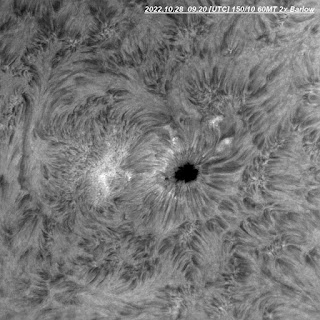*
Sunday 9th. 54F. Sunny, but white sky, high cloud and very persistent vapour trails. Seeing quite steady and fairly transparent to start. I had deliberately left the equipment set up overnight in the observatory. Just to see if this had any effect. I normally take everything important back indoors to avoid damp and cold.
10.19 Very odd! The image is superimposed on sand! Using 1448x1216 to cover AR3112 & 3116 spot group. Unfortunately this slows the video capture to only 58fps.The next capture was similarly covered in sand! 😟 Weird!
10.30 Lots more cloud has arrived from the SW.
10.39 Not quite so "sandy" but the Lunt etalon is badly tuned. The bottom half of the image is brighter and sharper than the top!
10.48 Retuned the etalon for even darkening and sharpness. Improving. The large frame size risk finding the limits of the Lunt's sweet spot. This is a result of using a larger aperture [150mm] than the Lunt 60mm system was designed for. Smaller frames and higher powers [magnification] will tend to stay within the sweet spot.
The sky, in the south east is veiled by thin, high cloud. With vapour trials being created by umpteen, crossing planes!
10.58 Using 912x912 for 88fps and much faster processing. Note the smaller field of view.
I am struggling to capture detail within the umbra after processing. The entire image is washed out if I try to keep the umbra.
The quality graph in AS!3 is showing better seeing conditions [contrast] so I have increased the stacking to 100/1000.
11.09 912x912 Deliberately left light in ImPPG. Used PhotoFiltre to darken and improve contrast.
11.16 800x800 100fps Even smaller field of view. Higher power but softer detail. The sky is clearer of thick cloud but thin, high cloud persists.
11.23 1936 x 1216 for maximum field of view.
Heavily cropped due to very light, top right corner.
11.38 1448 x 1216 Pushing the limits of the etalon sweet spot at top right.
11.48 1280x1024 78fps Reduced stack to 60 as image quality is dropping on the AS!3 graph.
1280x1024 allows AR3112/6 to be nicely framed and detailed.
12.11 1280x1024 Best so far? The sun is higher an in the gap between the house and the trees.
*










































